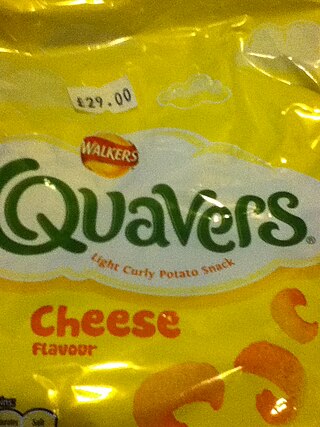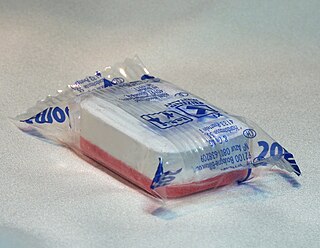
The H. J. Heinz Company is an American food processing brand and former company headquartered at One PPG Place in Pittsburgh, Pennsylvania. The company was founded by Henry J. Heinz in 1869. Heinz manufactures thousands of food products in plants on six continents, and markets these products in more than 200 countries and territories. The company claims to have 150 number-one or number-two brands worldwide. Heinz ranked first in ketchup in the US with a market share in excess of 50%; the Ore-Ida label held 46% of the frozen potato sector in 2003.

Ketchup or catsup is a table condiment with a sweet and sour flavor. The unmodified term ("ketchup") now typically refers to tomato ketchup, although early recipes for various different varieties of ketchup contained mushrooms, oysters, mussels, egg whites, grapes or walnuts, among other ingredients.

Fry sauce is a condiment often served with French fries or tostones in many places in the world. It is usually a combination of one part tomato ketchup and two parts mayonnaise. Historically, the Argentinian salsa golf is most likely the first ketchup and mayonnaise sauce, having been invented in the 1920s by Luis Leloir.

Quavers are a deep-fried potato-based British snack food. Launched in the UK in 1968, they were originally made by Smith's. Since 1997 they have been produced by Walkers. The name comes from the musical note, quaver.
The Arch Deluxe was a hamburger sold by the international fast food restaurant chain McDonald's in 1996 and marketed specifically to adults. Despite having the largest advertising and promotional budget in fast food history at the time, it was soon discontinued after failing to become popular. It is considered one of the most expensive product flops of all time.

Jif is a brand of natural strength lemon juice prepared using lemon juice concentrate and water, whereby the concentrate is reconstituted using water. After reconstitution, it is packaged and marketed. It is sold in the United Kingdom and Ireland by Unilever. Jif is used as a flavourant and ingredient in dishes, and as a condiment. Two tablespoons is around the equivalent of the juice of one lemon. The product has a shelf life of six months.

Heinz 57 is a synecdoche of the historical advertising slogan "57 Varieties" by the H. J. Heinz Company located in Pittsburgh, Pennsylvania, United States. It was developed from the marketing campaign that told consumers about the numerous products available from the Heinz company.

Kraft Foods Inc. was a multinational confectionery, food and beverage conglomerate. It marketed many brands in more than 170 countries. Twelve of its brands annually earned more than $1 billion worldwide: Cadbury, Jacobs, Kraft, LU, Maxwell House, Milka, Nabisco, Oreo, Oscar Mayer, Philadelphia, Trident, and Tang. Forty of its brands were at least a century old.
Keurig is a beverage brewing system for home and commercial use. The American company Keurig Dr Pepper manufactures the machines. The main Keurig products are K-Cup pods, which are single-serve coffee containers; other beverage pods; and the proprietary machines that use these pods to make beverages.

Heinz Tomato Ketchup is a brand of ketchup manufactured by the H. J. Heinz Company, a division of the Kraft Heinz Company.
When the predecessor of international fast food restaurant chain Burger King (BK) first opened in 1953, its menu predominantly consisted of hamburgers, French fries, soft drinks, milkshakes, and desserts. After being acquired by its Miami, Florida franchisees and renamed in 1954, BK began expanding its menu by adding the Whopper sandwich in 1957, and has since added non-beef items such as chicken, fish, and vegetarian offerings, including salads and meatless sandwiches. Other additions include a breakfast menu and beverages such as Icees, juices, and bottled waters. As the company expanded both inside and outside the United States, it introduced localized versions of its products that conform to regional tastes and cultural or religious beliefs. To generate additional sales, BK occasionally introduces limited-time offers of special versions of its products, or brings out completely new products intended for either long- or short-term sales. Not all of these products and services have been successful; in 1992, Burger King introduced limited table service featuring special dinner platters, but this concept failed to generate interest and was discontinued.

Kool-Aid is an American brand of flavored drink mix owned by Kraft Heinz based in Chicago, Illinois. The powder form was created by Edwin Perkins in 1927 based upon a liquid concentrate called Fruit Smack.

The Big N’ Tasty is a hamburger sold by the international fast food chain McDonald's. It is designed to compete with the Whopper sandwich. A similar variation called the Big Tasty, without the center "N'", which was first released in Saudi Arabia, is sold outside the United States in parts of Europe, South America, South Africa, The Middle East, and Taiwan.

Velveeta Shells & Cheese is a shell pasta and cheese sauce food product that debuted in the United States in 1984, as part of the Velveeta brand products. Its ingredients, texture, and flavor are very similar to macaroni and cheese. The product is a shelf-stable food.

A packet or sachet is a small bag or pouch, made from paper, foil, plastic film or another type of packing material, often used to contain single-use quantities of foods or consumer goods such as ketchup or shampoo. Packets are commonly opened by making a small rip or tear in part of the package, and then squeezing out the contents.

The Kraft Heinz Company (KHC), commonly known as Kraft Heinz, is an American multinational food company formed by the merger of Kraft Foods and H.J. Heinz Company co-headquartered in Chicago and Pittsburgh. Kraft Heinz is the third-largest food and beverage company in North America and the fifth-largest in the world with over $26.0 billion in annual sales as of 2021.

Sir Kensington's is an American food company with headquarters in New York City, New York. It was founded by Mark Ramadan, Scott Norton, Brandon Child, and Win Bennett. The company produces Non-GMO Project Verified condiments including ketchup, mustard, mayonnaise, ranch dressing, and "Fabanaise", a vegan mayo whose name is a portmanteau of the substitute ingredient aquafaba and mayonnaise which it mimics.















